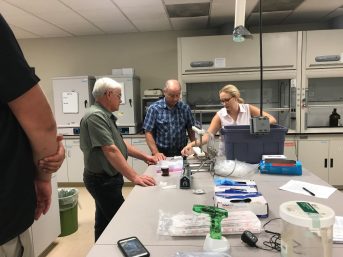Utah officials trained on HABs monitoring techniques at SCCWRP

SCCWRP in August trained representatives from the Utah Department of Agriculture and Food on techniques for monitoring harmful algal blooms (HABs) in irrigation systems in Utah, part of an effort to examine whether cyanotoxins are being transferred to agricultural products intended for human consumption.
The Utah Department of Agriculture and Food visited SCCWRP to learn how to deploy a passive sampling technology known as Solid Phase Adsorption Toxin Tracking (SPATT). SPATT consists of a device that absorbs biotoxins onto porous, resin-filled sachets; the biotoxins are then extracted and analyzed.
Utah officials are interested in monitoring HABs in irrigation systems because toxins have been documented in vegetables. Researchers want to learn whether irrigation water can provide a pathway for toxins to be transferred into agricultural products.
The Utah pilot project is part of a coordinated, multi-agency effort to develop more robust HABs monitoring methods for a variety of aquatic systems, and to understand relationships among HABs events at the land-sea interface.
More news related to: Eutrophication, Harmful Algal Blooms